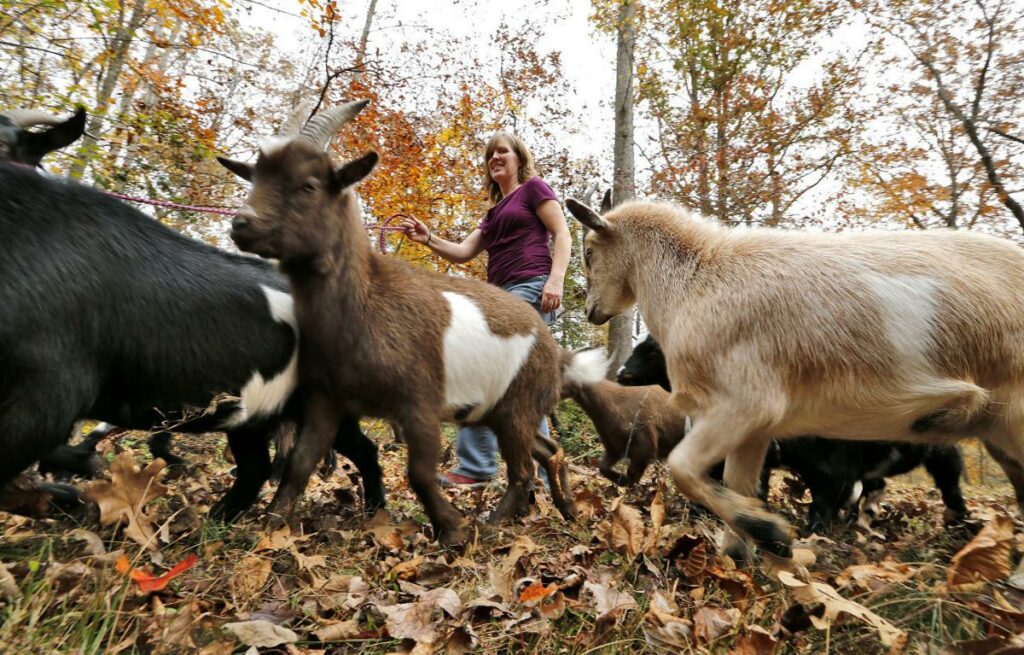Originally posted by Rex Springston in the Richmond Times-Dispatch on November 16, 2015
Kristi Orcutt often carries her work home with her. Sometimes her work sits on the couch and watches TV with her.
Orcutt, 50, raises goats, which she hires out as living weed whackers for places being overtaken by unwanted plants.
But to Orcutt, her 20 goats are more than livestock. They are pets, and it’s not unusual to find one in the house. The work they do, she said, is not just a business but a boon to the environment.
“Hello, darling. Oh, I love you,” the sandy-haired Orcutt cooed into the ear of a goat named Clover the other day as the affectionate animal ran up to her in a temporary pen at Richmond’s Bryan Park.

Clover and 11 other goats were doing a chomp job at the North Richmond landmark, ridding it of Japanese stilt grass, English ivy and other invasive species.
Anecdotal evidence suggests goats are becoming increasingly popular as weed controllers, said Scott Greiner, a Virginia Tech professor of animal sciences.
Some people prefer goats to herbicides, but Greiner said both can be used safely and effectively. “I think it’s more of (a) philosophical thing” that leads people to goats, he said.
In Richmond alone, goats have been deployed in recent years in places including James River Park, Byrd Park and the Church Hill area.
But Orcutt and her crew are different.
The leaf-chewing, head-butting, stump-jumping goats draw onlookers, to which Orcutt, a longtime environmental educator, spreads the word about caring for the natural world. She’s sort of a bleating heart.
“I’m trying to foster stewardship,” Orcutt said. “Profit will probably never enter into it.”
Peter Hains of North Richmond often bikes along an old road in northwestern Bryan Park, which was weed-choked before the goats arrived. “I think they’re a great idea,” Hains said, watching the animals. “They add a little color to the neighborhood.”
The goats had nibbled the weeds to the ground and were awaiting transfer to another section of the park.
The Friends of Bryan Park, a nonprofit group, hired Orcutt to clear about 2.5 acres for about $3,000, said John Zeugner, the group’s president.
That’s about what the group would’ve paid to hire people to spray herbicides or remove plants by hand, Zeugner said.
“We like the idea of a kind of holistic way of attacking the invasives,” Zeugner said.
Zeugner’s group is investigating how to keep the bad plants from taking over again. Options include trimming by hand or perhaps bringing back the goats.
Orcutt, a Fairfax County native, holds a biology degree from Virginia Commonwealth University. A former educator and interim manager at Rockwood Park’s nature center in Chesterfield County, she works developing children’s programs at Lewis Ginter Botanical Garden.
Some of Orcutt’s goats have even put their plant-removal skills to work at the garden.
At home, Orcutt runs Bright Hope Farm near Pocahontas State Park in Chesterfield with friend Harlan Williams.
“She’s the top goat herder,” Williams said. “I’m the lackey.”
At the farm, Orcutt also raises bees, chickens, a rescued Jack Russell and a rescued corn snake.
“I’ve always been one of those nerdy people who loved nature and found refuge in it,” Orcutt said.
The goats are her favorites. She takes the animals jogging with her — one on a leash, the others following. Sometimes Clover comes in to watch TV with Orcutt from the couch.
Orcutt’s goats are Nigerian dwarfs and pygmies, two of the smaller breeds.
“I chose them because I knew nothing (when getting into goats two years ago), so I figured I’d better start off small,” she said.
In folklore, goats and their cloven hooves are often associated with the devil, but Orcutt’s animals couldn’t be sweeter. The smallest goat working at Bryan Park was a young, fawn-sized pygmy named Daisy. Her contribution looked almost like child labor, but Daisy bore a contented look.
The big-bellied goats are surprisingly solid and graceful, easily bounding over barriers or atop rocks.
Orcutt said she is constantly learning about her goats and what they are trying to say with their body language. “I feel like Jane Goodall with chimpanzees.”
It’s an urban jungle out there, sure enough, but for the goats, it suits their taste.


